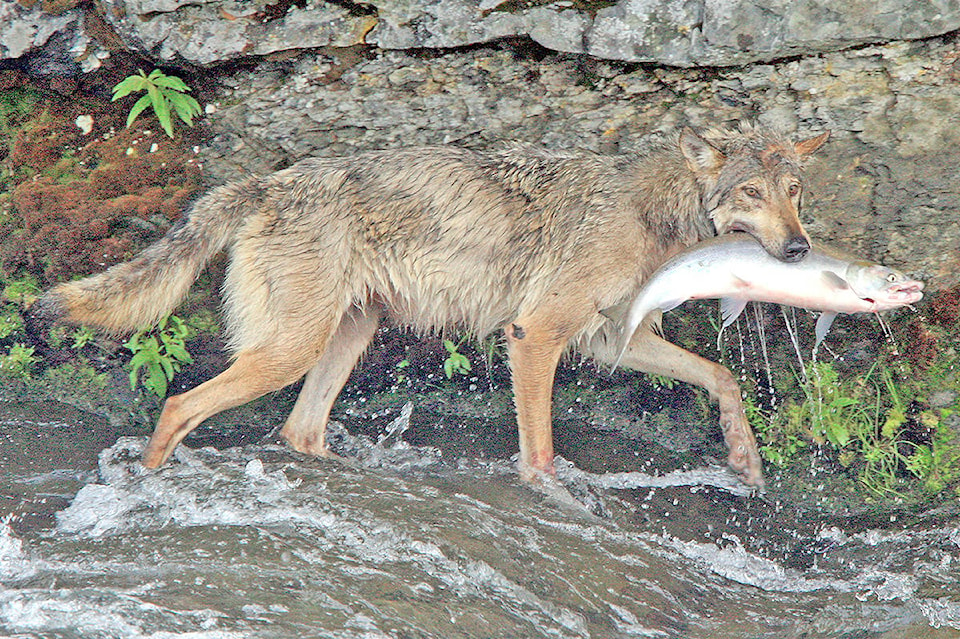Erin Linn McMullan
Special to the Westerly
Once a wolf aims that gaze that “sees inside your soul,” you are forever changed.
“I had spent much of my career dreaming of moments like this, of coming face to face with a wild wolf and staring into its piercing yellow eyes, of finally getting the glorious Nat Geo-type shots I had missed out on so many years before with that black wolf on the train tracks in Banff,” wrote John Marriott in Tall Tales, Long Lenses: My Adventures in Photography. “But I never expected an encounter so intimate that I was unable to photograph it.”
That close relationship made the wolf Delinda’s image all the more iconic and haunting, becoming Canadian Geographic’s best selling cover of all time a year after she was killed once she slipped through a fence onto the Trans-Canada Hwy.
Human conflict is the second-leading cause of wolf fatalities after interspecies conflict; only four deaths of humans by wild wolves have been recorded in North America over the past century.
READ MORE: Leashes and owner’s actions keep Ucluelet dogs safe during wolf encounter
Author Paula Wild was surprised when researching Return of the Wolf: Conflict and Coexistence by how polarized people’s views of wolves are. “It was shocking. I wasn’t prepared for that much hate or that much love.”
“The word wolf is synonymous with conflict,” she writes, advocating we move “beyond the perception of the wolf as poster image for the wilderness or savage killer and look at the wolf in a more holistic way.”
Over tens of thousands of years of shared history, our mixed feelings have been expressed through art, from the earliest cave paintings to the ‘big bad Wolf’ in fairy-tales, to embodying the spirit of adventure in Jack London’s Call of the Wild.
Scientists compare complex wolf societies to ours: they live in families and show a depth of feeling when mourning lost loved ones, or trying to rescue a trapped pack member, they mate for life and they wage war.
Nevertheless, Wild cautions, it can be dangerous to project human behaviour onto wolf behaviour.
The wolf is simply an animal making a living by its teeth and, as an apex predator, can even play a vital role in the ecosystem – witness the stunning regeneration of Yellowstone National Park in the US after the reintroduction of wolves in 1995.
Wild also spoke with ranchers implementing new non-lethal methods to avoid conflict, including livestock guardian dogs but making only slow inroads with entrenched attitudes towards wolves. What tips us from wonder to fear?
READ MORE: Wolves that attacked dog in Tofino will not be killed
Wolves are incredibly smart. With each voice as distinct as a fingerprint, wolves communicate through vocalization, body language, scent and silently, in ways we don’t understand as witnessed by the helicopter pilot observing a sheep ambush choreographed with military precision.
Some scientists discern different dialects, suggesting European wolves hold their notes like an opera singer while North American wolves constantly change pitch, improvising like a jazz combo. Wild emphasizes that on the West Coast, for the most part, we do a really good job of co-existing, even though we share a thin strip of land for travel and living corridors. Our ‘sea wolves’ do differ genetically from those in interior B.C., but have not yet been declared a distinct species or subspecies.
READ MORE: Wolf killed in Pacific Rim National Park Reserve between Tofino and Ucluelet
Respect for the wolf is integral to traditional coastal culture and, as Joe Martin points out, killing wolves is against Tla-o-qui-aht First Nation law.
“Wolves have always been an essential part of coastal landscapes and they are here to stay,” says Bob Hansen, who specializes in wildlife-human conflicts. “Human actions are essential to the co-existence challenge.”
READ MORE: WildSafeBC program returns to Tofino and Ucluelet
The most obvious explanation for our fascination lies in our bond with our dogs, whose ancestors split off from wolves about 40,000 years ago.
Wild recounts her own near-mystical close encounter while emphasizing that she now considers wildlife in a more wide-open way, “like a five-year-old who is so amazed at everything.”
Wild presented Return of the Wolf on November 13th at the Clayoquot Sound Community Theatre in Tofino.
READ MORE: Reflecting Spirit offers tapestry of West Coast stories
READ MORE: Tofino art shop welcomes youth to creative spaces
READ MORE: Streetly’s book launch captures Tofino magic with evening of storytelling
